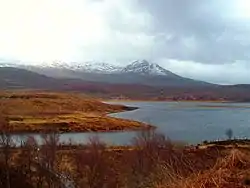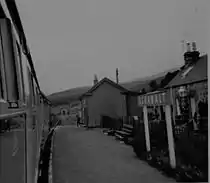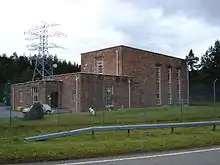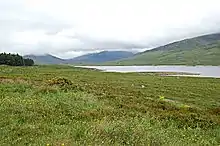Achanalt
Achanalt (Gaelic: Achadh nan Allt) is a railway halt in Strath Bran, Ross and Cromarty, in the Scottish council area of Highland. It is served by a railway station on the Kyle of Lochalsh Line from Inverness to Kyle of Lochalsh.
Achanalt
| |
|---|---|
 Loch Achanalt | |
 Achanalt Location within the Ross and Cromarty area | |
| OS grid reference | NH261615 |
| Council area | |
| Country | Scotland |
| Sovereign state | United Kingdom |
| Postcode district | IV23 2 |
| Police | Scotland |
| Fire | Scottish |
| Ambulance | Scottish |
| UK Parliament | |
| Scottish Parliament | |
History

The Achanalt railway station was opened by the Dingwall and Skye Railway, but operated from the outset by the Highland Railway. Taken into the London, Midland and Scottish Railway during the Grouping of 1923, the line then passed on to the Scottish Region of British Railways on nationalisation in 1948. When Sectorisation was introduced, the station became part of ScotRail until the Privatisation of British Rail.
The Achanalt Power Station, commissioned in 1957 by James Shearer, lies less than a mile southwest of the Grudie Bridge Power Station.[1]
Culture
Sir Arthur Bignold, MP for Wick Burghs in the early 20th century, was the proprietor of the Achanalt Inn (now Achanalt House),[2] built in 1878.[3] Bignold acquired the estates of Lochrosque and Strathbran, including the villages of Achanalt and Achnasheen, a castle at Lochrosque and lodges at Cabuie and Strathbran in 1885.[4] Cabuie Lodge was lost below the waters of Loch Fannich in the 1950s and Lochrosque Castle has also been demolished.[5] The estate at Strathbran including Achanalt passed to Bignold's grandson the Marquis de Torrehermosa and his family continue to live at Strathbran Lodge in Achanalt.[6][7]
The steeply sloping Cnoc na Bhain burial ground, one of Scotland's most beautiful graveyards, contains a memorial and grave of the pioneer aviator, Captain Bertram Dickson.[8]
Geography

The village lies on the A832 road and the River Bran, and is near to the western shore of Loch Achanalt.[9] To the north is Loch Fannich. The terrain in the area is rugged and marshy, typical of this part of the Highlands. The dominant local geographical feature is Loch Achanalt, roughly quadrangular, with a maximum diameter of approximately 0.75 mi (1.21 km).[10] Its water is shallow and reedy, and drains over 39 square miles (100 km2), including the River Bran.[11] The area between Achanalt and Achnasheen is characterised by a gentle slope down to the River Bran, and features two peaks, Scuir Vuillin and Scuir a Ghlas Leathaid 2,800 ft (850 m).[12]
Fauna and flora

The Achanalt reservoir[13] and marshes were designated a Site of Special Scientific Interest on 18 May 1989 as the area is an important nesting ground. It is 214.6 hectares (530 acres) in size.[14] The marshes are characterised by mesotrophic grassland on a river valley flood plain. There are two waterlogged Carex Juncus communities that include bottle sedge, marsh pennywort, and bogbean. In a relatively drier area, short grass and sedge occur, mainly in winter. The marshes are sedge dominated, and these include common sedge, carnation sedge, flea sedge, and star sedge. Tawny sedge and dioecious sedge occur in flush line areas. The featured herbs include heath spotted orchid and common valerian. Purple moor grass and tufted hair grass are locally extensive. Four nationally rare species of breeding birds are located here.[14]
The open water and grassland areas of Achanalt marshes support an array of nesting birds. Waders include common sandpiper, curlew, dunlin, lapwing, oystercatcher, redshank, ringed plover, and snipe. Wildfowl include mallard, red-breasted merganser, teal, tufted duck, and wigeon. There is also a black-headed gull colony.[14]
References
- "Achanalt Power Station". Scottish Places Info. Retrieved 20 October 2010.
- Shennan, Hay (1892). Scotland Boundary Commissioners (ed.). Boundaries of counties and parishes in Scotland as settled by the Boundary Commissioners under the Local government (Scotland) act, 1889. W. Green. p. 135.
Achanalt Inn.
- "Architectural Plan of Achanalt Inn". scotlandsplaces.gov.uk. Archived from the original on 3 September 2012. Retrieved 22 October 2010.
- Addison, Henry Robert; Oakes, Charles Henry; Lawson, William John (1905). Who's who. 57. A. & C. Black. p. 136.
- "NH2064 : Sign for Cabuie Lodge". geograph.org.uk. Retrieved 22 October 2010.
- "Register of Scottish Architects". scottisharchitects.org.uk. Retrieved 21 November 2011.
- "Achnasheen and Garve Community Website". achnasheenandgarve.com. Retrieved 21 November 2011.
- Nicoll, Ruaridh (21 December 2003). "The Wrights' stuff We worry about aircraft polluting our lives when really they are enriching it". The Guardian. Retrieved 22 October 2010.
- Google Maps (Map). Google.
- The Geographical journal, Volume 26. Royal Geographical Society. 1905.
Achanalt.
- Scottish geographical magazine, Volume 23. Royal Scottish Geographical Society. 1907. p. 199.
- Harvie-Brown, John Alexander; Buckley, Thomas E. (1895). A fauna of the Moray basin. 1. D. Douglas. p. 48.
- Judy Trinnaman, Alan Clarke (2004). Survey of energy resources (20 ed.). World Energy Council, Elsevier. p. 200. ISBN 0-08-044410-5.
- "Achanalt Marshes, Site of Special Scientific Interest: Highland (Easter Ross and Cromarty)". apps.snh.gov.uk. Retrieved 20 July 2020.